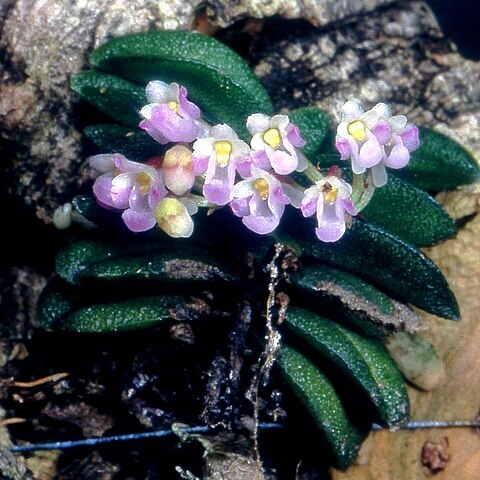Herbs, epiphytic, monopodial, small. Stems pendulous or ascending, with condensed or elongated internodes, to 30 cm, sometimes branched, with several to many nodes. Leaves flat to subterete, fleshy, with sheathing base, blade jointed to sheath. Inflorescence axillary, racemose or paniculate, many flowered. Flowers usually not opening widely, white or red-purple, small, fleshy. Sepals similar, free, often dorsally carinate. Petals free, smaller than sepals; lip thickly fleshy, adnate to base of column, immovable, longer than petals, spurred at base, 3-lobed; lateral lobes erect; mid-lobe slightly larger, often spatulate; spur large, usually parallel to ovary, lacking interior calli. Column very short, stout, foot absent; stigma at base of column; anther and rostellum, pointed, geniculate; pollinia 4, appearing as 2 unequal masses, waxy, flat-globose or subglobose, attached by a common stipe to a narrowly elliptic to ovate viscidium.
More
Small epiphytic orchids, some species branching freely to form untidy clumps, others hardly branching at all. Roots thin, smooth, spreading. Stems thin. Leaves narrow, linear or terete or relatively broad. Racemes/panicles short. Flowers resupinate, tiny, appearing tubular because the sepals and petals overlap and do not spread widely. Sepals and petals free, similar in size and shape. Labellum immovably fixed to base of column. Labellum 3-lobed, often papillate; lateral lobes short, broad; midlobe short, fleshy; spur prominent, broad. Column short, without basal foot. Pollinia 4 in 2 unequal pairs, orange, hard, waxy, stalked, attached via long, narrow stipe to large viscidium.

